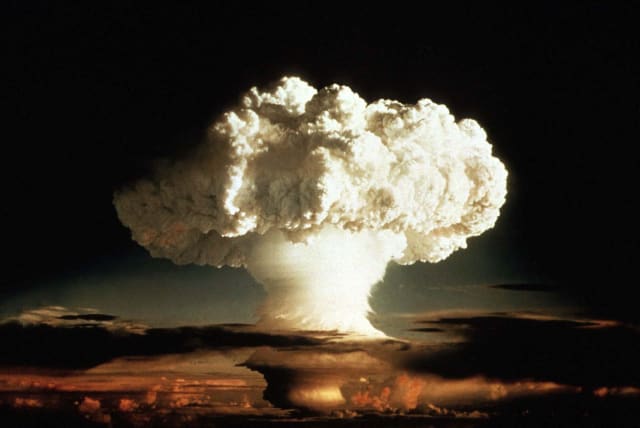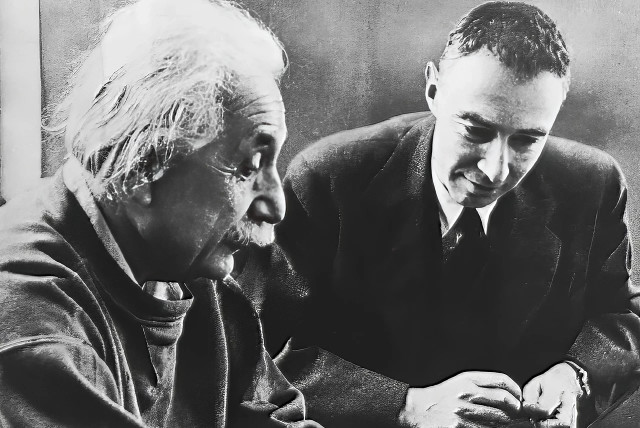'Oppenheimer': How Jewish refugees beat the Nazis to the atomic bomb - opinion

Many Jewish scientists who fled Nazi Germany would work on the Manhattan Project. They knew how important it was to beat Hitler to getting nuclear bombs first.
An intelligent and sensitive friend asked me recently if I thought she would cringe if she went to see the movie Oppenheimer because of the involvement of Jews in creating the atom bomb.
Just the opposite, I told her.
Consider for a moment what the world would have been like if the Nazis had succeeded in building the bomb first.
The justifiably much-praised movie, based on the Pulitzer Prize-winning biography American Prometheus: The Triumph and Tragedy of J. Robert Oppenheimer by Martin J. Sherwin and Kai Bird, doesn’t obscure the Jewish identities of J. Robert Oppenheimer and most of the other scientists. (Although you won’t find their Jewishness mentioned on the Wikipedia entry for Los Alamos, home of the secret Development of Substitute Materials, better known as the Manhattan Project.)
I would have liked more insight into what must have been fascinating personal conversations among these scientists for whom Jewish observance was secondary to scientific passion – persecuted for their Jewish genes and meeting in safety in the United States.
The importance of Jewish refugees in making the atomic bomb before the Nazis
Let us not forget that in the sciences before World War II, Germany was far ahead of America. In the first 32 years of the Nobel Prizes (1901-32), before the Jews were expelled from their classrooms and laboratories, Germany won 33 Nobels. Great Britain won 18. The huge United States of America had won only six.
These awards crowned Germany’s half-century of scientific advancement.
At the same time, antisemitic controversy was already brewing in the ranks of German science. Aryan physicists Philipp Lenard and Johan Stark derided “Jewish science,” calling the breakthroughs in relativity and quantum mechanics by Albert Einstein and his colleagues “a Jewish bluff.” Lenard, who was awarded the Nobel Prize in 1905 for his research into the properties of electrons (“cathode rays”), wrote, “There was a Jewish way of doing science, which involved spinning webs of abstract theory, detached from the firm and fertile soil of experimental work.”
After Adolf Hitler was appointed Reich chancellor in January 1933, the Law for the Restoration of the Professional Civil Service was passed that April and became the basis for expelling staff of Jewish descent from government agencies. In Hitler’s words, “If the dismissal of Jewish scientists means the annihilation of contemporary Germany science, then we shall do without science for a few years.”
Renowned and not-yet-renowned scientists were fired from their jobs. Many found positions abroad. More than 1,000 scientists moved to the US. Among the Jewish scientists who were booted out by the Nazis, 15 would go on to win Nobel Prizes. Of the Jewish scientists who did not or could not flee, many were imprisoned and murdered in concentration camps.
Before seeing Oppenheimer, I made a long list of the Jewish scientists who were banished, not only obvious names like “Viki” Weisskopf but also less Jewish-sounding names like Rudolf Peierls and Hans Bethe, plus Niels Bohr, whose mother was a Sephardi Jew. In a more liberal definition of who was a Jew than would be accepted by our rabbinical officials, possession of even a single Jewish grandparent disqualified academics from teaching and influencing their German students. A few more include Edward Teller, Leo Szilard, and Lise Meitner.
Eight decades after World War II, Los Alamos – beautiful, ethereal and isolated – is still a company town. After the war, the US Congress decided to keep the well-equipped laboratory there and establish the civilian Atomic Energy Commission. The Los Alamos National Laboratory (affectionately known as “the Lab”) was moved from downtown to a nearby mesa. Gray and beige utilitarian-looking buildings cover 43 square miles of forests and canyons. Today, some 12,000 employees – less than a tenth of those who worked at the peak of the Manhattan Project – conduct security, space, and energy research.
LOS ALAMOS today has a Jewish center and a Hadassah chapter, where I’ve been privileged to speak. I remember apologizing to my physicist-filled audience that I was giving an amateur’s description of the concussive waves that tore the lungs of passengers in Israel in the Intifada bus bombings.
Ubiquitous petroglyphs by nomads and Indians are sketched in the local soft volcanic stone, but Los Alamos’s modern history reaches only as far back as 1911, when the area was first homesteaded by white settlers. The Los Alamos Ranch School for boys offered rigorous studies with vigorous outdoor living. Students slept in unheated log cabins and rode horses on pack trips up into the mountains. Oppenheimer’s parents in New York sent their slender, gifted teenage son to the school to improve his health. When, later in life, he was tasked with organizing and running the Development of Substitute Materials, he chose that location.
As I said, it is beautiful, ethereal, and isolated.
The movie Oppenheimer goes back and forth between the build-up to the bomb’s Trinity test and the inquisition of Oppenheimer during the post-war McCarthy period, in which he lost his security clearance. Leading the testimony against him was Lewis Strauss, who felt little empathy for his fellow Jew.
While Oppenheimer and his dream team worked in the mesas of Los Alamos, a Nazi team headed by their once-colleague Werner Heisenberg was working in the secret lab of Hechingen near the Black Forest in Germany. According to University of Haifa physicist Alex Gordon, the Nazis had provided funding to build a cyclotron to separate the uranium 235 isotope (from bulk uranium) needed to produce a bomb. The refugee scientists in Los Alamos understood the consequences of the race. Their relatives were being incarcerated, tortured, and murdered in their home countries
As Gordon wrote in the online magazine Mosaic in 2021, “Their zoological hatred of the Jews boomeranged back to them. In the work of the Manhattan Project, perhaps the only real Jewish conspiracy in history took shape, a conspiracy of Jews against the Nazis who had made them aliens in their own country.”
Likewise, a book by Jean Medawar and David Pyke, with the inspired title Hitler’s Gift, documents the irreplaceable contribution of the banished Jewish science to America’s success.
Living in Jerusalem, I’m familiar with “Hitler’s gift” to us, too. Doctors and nurses who were railroaded out of Central and Eastern Europe found professional homes in Israel and advanced Israeli science and medicine.
Take, for example, Bernard Zondek, one of the developers of the first pregnancy test. Zondek was among the Jews cast out of Berlin’s Charite Hospital. If you look up Charite University Hospital, you’ll see that it boasts of its 300-year history and claims Zondek among its stars. But by 1934, Zondek had left Berlin and was already pursuing his medical career and research as a professor of obstetrics and gynecology at the then nine-year-old Hebrew University of Jerusalem and head of obstetrics and gynecology at the then 16-year-old Hadassah Medical Organization.
Zondek was happily received in Jerusalem as an immigrant, not as a refugee.
The writer is the Israel director of public relations and communications at Hadassah, the Women’s Zionist Organization of America. Her latest book is A Daughter of Many Mothers.
Jerusalem Post Store
`; document.getElementById("linkPremium").innerHTML = cont; var divWithLink = document.getElementById("premium-link"); if (divWithLink !== null && divWithLink !== 'undefined') { divWithLink.style.border = "solid 1px #cb0f3e"; divWithLink.style.textAlign = "center"; divWithLink.style.marginBottom = "15px"; divWithLink.style.marginTop = "15px"; divWithLink.style.width = "100%"; divWithLink.style.backgroundColor = "#122952"; divWithLink.style.color = "#ffffff"; divWithLink.style.lineHeight = "1.5"; } } (function (v, i) { });

